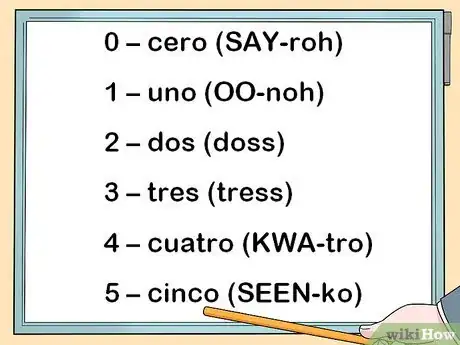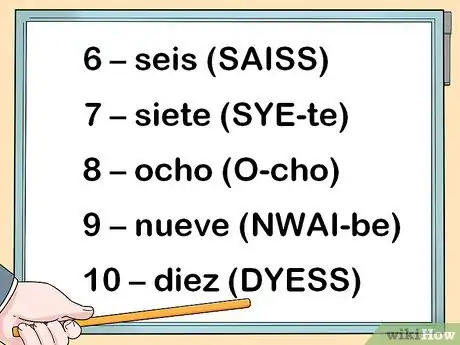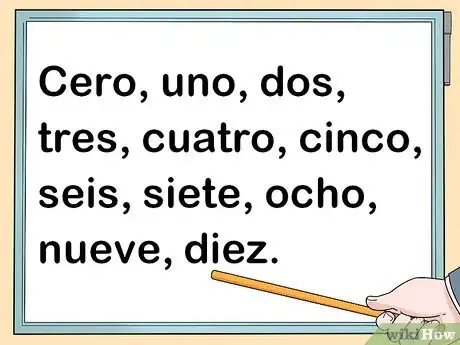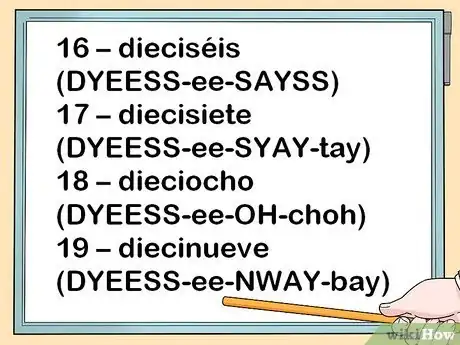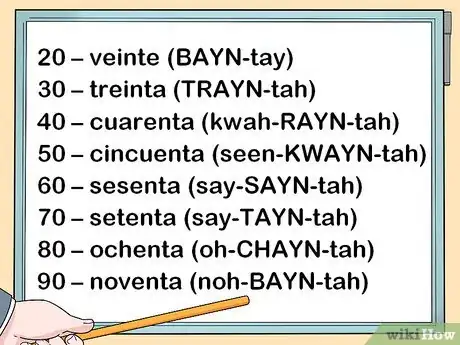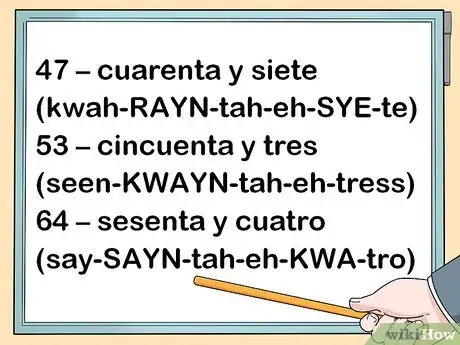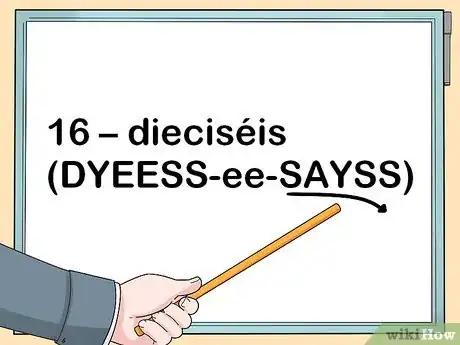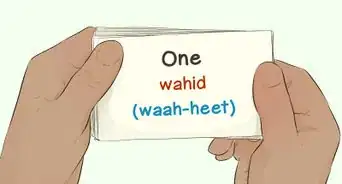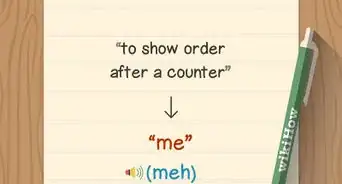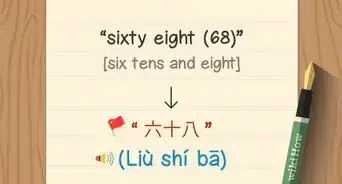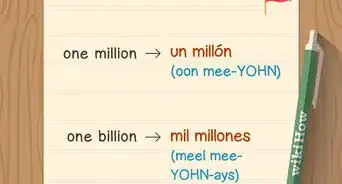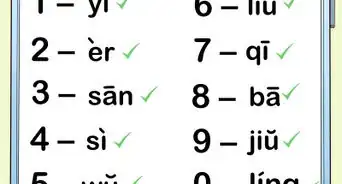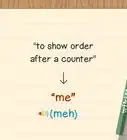This article was co-authored by Diana Con Webber and by wikiHow staff writer, Jennifer Mueller, JD. Diana Con Webber is a Teacher in Arizona. She received her Standard Elementary Education, K-8 Certificate in 2017.
This article has been viewed 398,336 times.
When you start learning another language, one of the first things you'll master is how to count. This skill serves as a building block to other aspects of the language. Once you know numbers, you'll be able to quantify groups of things as well as understand how much items cost when you go shopping. Start small and learn to count up to 10 in Spanish, and from there you can form other numbers more easily.[1]
Steps
Counting to Ten
-
1Start by learning to count to 5. It may be easier for you to learn how to count to 10 (and beyond!) if you split the numbers into chunks. Memorizing shorter sequences is easier than trying to learn all the numbers at once. Repeat the words until you can say them without thinking.[2]
- Although not typically included in counting, you can say zero (0) in Spanish as cero (SAY-roh).
- One (1) in Spanish is uno (OO-noh).
- Two (2) in Spanish is dos (doss).
- Three (3) in Spanish is tres (tress).
- Four (4) in Spanish is cuatro (KWA-tro).
- Five (5) in Spanish is cinco (SEEN-ko).
-
2Learn the numbers for 6 through 10. Once you've committed the Spanish words for numbers one through five to memory, you're ready to move on to the next set of numbers. Repeat the new numbers over and over until you know them as well as you know one through five.[3]
- Six (6) in Spanish is seis (SAISS).
- Seven (7) in Spanish is siete (SYE-te).
- Eight (8) in Spanish is ocho (O-cho).
- Nine (9) in Spanish is nueve (NWAI-be).
- Ten (10) in Spanish is diez (DYESS).
Advertisement -
3Put it all together to count to 10. When you have both sets of numbers memorized, all you have to do is put them in a single series and say them all together. You now know how to count up to 10 in Spanish.[4]
- Count to 10 repeatedly until the words are automatic for you.
- One way to incorporate the Spanish words into your every day life is to try to automatically think of the Spanish word for the number when you're looking at a number of items.
- For example, if you have a bowl of fruit in your kitchen that has 2 apples, 3 bananas, and 7 oranges, you might think to yourself that there are dos apples, tres bananas, and siete oranges. It doesn't matter whether you know the Spanish words for those fruits.
Learning Further Numbers
-
1Memorize the numbers 11 through 15. There's no point in stopping once you've learned to count up to 10 in Spanish. Using the same strategy you did when you learned to count to ten, learn the Spanish words for the numbers 11 through 15. The Spanish language has unique words for these numbers.[5]
- For eleven (11), say once (OHN-say).
- For twelve (12), say doce (DOH-say).
- For thirteen (13), say trece (TRAY-say).
- For fourteen (14), say catorce (kah-TOHR-say).
- For fifteen (15), say quince (KEEN-say).
-
2Study the numbers 16 through 19. When you learn numbers 16 through 19, you're also learning how all the other numbers in Spanish are formed. You'll take the word for 10, diez, include an ee sound ("y" in Spanish means "and"), and then the word for the second digit.[6]
- Sixteen (16) is dieciséis (DYEESS-ee-SAYSS).
- Seventeen (17) is diecisiete (DYEESS-ee-SYAY-tay).
- Eighteen (18) dieciocho (DYEESS-ee-OH-choh).
- Nineteen (19) is diecinueve (DYEESS-ee-NWAY-bay).
-
3Count in tens. To figure out how to form other numbers in Spanish, you'll have to memorize the base numbers by learning how to count in tens. These number words are the building blocks for saying larger numbers in Spanish.[7]
- For twenty (20), say veinte (BAYN-tay).
- For thirty (30), say treinta (TRAYN-tah).
- For forty (40), say cuarenta (kwah-RAYN-tah).
- For fifty (50), say cincuenta (seen-KWAYN-tah).
- For sixty (60), say sesenta (say-SAYN-tah).
- For seventy (70), say setenta (say-TAYN-tah).
- For eighty (80), say ochenta (oh-CHAYN-tah).
- For ninety (90), say noventa (noh-BAYN-tah).
-
4Understand how to form other numbers. Now that you know how to count to 10, and you know how to count in tens, you can easily combine your knowledge to say or write in Spanish any number up to 99.[8]
- Keep in mind that the spelling may differ, and you may need to stress different syllables.
- However, if you understand the basics of how numbers are formed, you can at least recognize any number you see or hear in Spanish.
- As with everything else, remember to practice this skill regularly and repeat the numbers to yourself at least once every few days.
- Over time, counting in Spanish will become second nature to you.
Perfecting Your Pronunciation
-
1Review basic accentuation rules. In Spanish, if you see an accent mark over a letter, it tells you that you are supposed to stress or emphasize that syllable when you pronounce the word. Some Spanish words are spelled the same way, but mean entirely different things depending on which syllable is stressed.[9]
- The essential accentuation rule in Spanish is that if the word ends in a vowel, an n, or an s, you'll put stress on the last syllable.
- However, if the word has an accent mark, you stress that syllable and ignore the general rule.
- For example, in your numbers, you may have noticed an accent in the word for sixteen (16), dieciséis. This means that you should stress the syllable with an accent, which is the last syllable.
-
2Watch TV shows or movies in Spanish. Listening to people speak Spanish can help you understand more about how the words fit together and how they're said in the context of normal conversation.
- Actors typically pronounce their words without excessive regional dialect—unless the show or movie takes place in a specific geographic area. This makes it easier for you to learn the language.
- Keep in mind that Spanish is spoken in many countries all over the world, giving rise to multiple dialects and variations. Even for a native speaker, someone from another country can be difficult to understand.
-
3Listen to Spanish music. Music can be an easy way to learn a language because of the rhythm and repetitiveness of the lyrics. If you find music with Spanish lyrics that appeals to you, listening to it on a regular basis can help you understand how words are pronounced.
- If you think back to how you learned your first language, you'll probably recall that there was a lot of music involved. Songs are a very efficient way to learn words and how they fit together.
- You may not understand exactly what something means, but the important part when you're just beginning to learn Spanish is to listen to the way the words are pronounced and how the language sounds.
-
4Talk to native speakers. When you're learning any no language, there's nothing better to enhance your understanding of the language and the way the words are spoken than to talk to people who are fluent in the language.
- Native speakers also can correct your pronunciation and give you tips on how to pronounce the words correctly.
- Particularly if you have another language in common, a native speaker may be able to give you tips on how to pronounce words in Spanish that you wouldn't have picked up on otherwise.
Community Q&A
-
QuestionWhere can I learn to speak Spanish online?
 Community AnswerOne of the most commonly used websites is Duolingo.
Community AnswerOne of the most commonly used websites is Duolingo. -
QuestionHow do I say "100" in Spanish?
 Community Answer"Cien" is 100 in Spanish. And if you're counting from 100 up, you would use "ciento" plus the next number, such "ciento uno," etc.
Community Answer"Cien" is 100 in Spanish. And if you're counting from 100 up, you would use "ciento" plus the next number, such "ciento uno," etc. -
QuestionWhat is 5 in Spanish?
 Iris8989Community AnswerThe number five is called "cinco" (you pronounce it like SEEN-CO) in Spanish.
Iris8989Community AnswerThe number five is called "cinco" (you pronounce it like SEEN-CO) in Spanish.
References
- ↑ http://www.fluentu.com/spanish/blog/counting-in-spanish/
- ↑ https://www.spanishtown.ca/spanishforkids/grade1/monthlyvocabulary/month1activities/audio-numeros-0-10.htm
- ↑ https://www.spanishtown.ca/spanishforkids/grade1/monthlyvocabulary/month1activities/audio-numeros-0-10.htm
- ↑ https://www.spanishtown.ca/spanishforkids/grade1/monthlyvocabulary/month1activities/audio-numeros-0-10.htm
- ↑ https://www.spanishtown.ca/spanishforkids/grade1/monthlyvocabulary/month3activities/audio-numeros21-30.htm
- ↑ https://www.spanishtown.ca/spanishforkids/grade1/monthlyvocabulary/month3activities/audio-numeros21-30.htm
- ↑ https://www.spanishtown.ca/CountingInSpanish.html
- ↑ https://gogoespana.com/en/blog/numbers-in-spanish-1-100/
- ↑ https://catalog.ldc.upenn.edu/docs/LDC2019S07/Rules_for_Spanish_Accent_Marks.pdf
About This Article
To count up to 10 in Spanish, say "uno, dos, tres, cuatro, cinco, seis, siete, ocho, nueve, diez." If you want to learn where to put the accent when you're counting in Spanish, keep reading the article!
